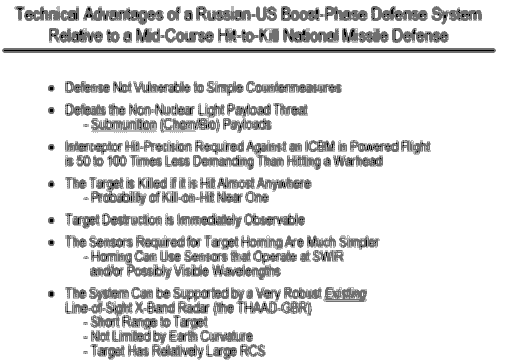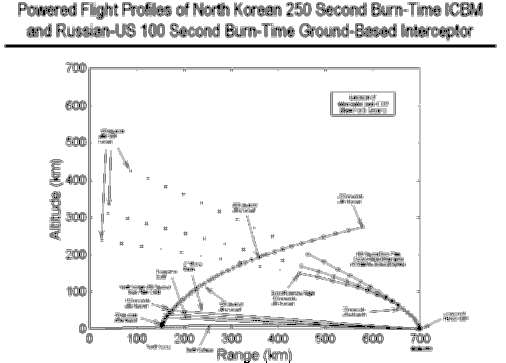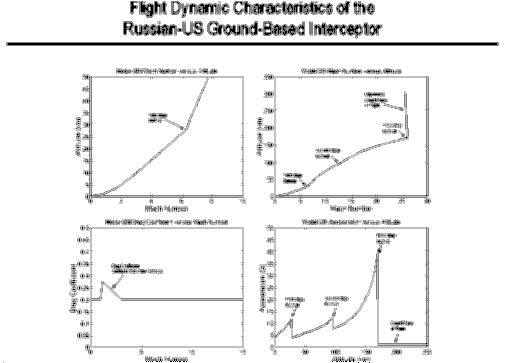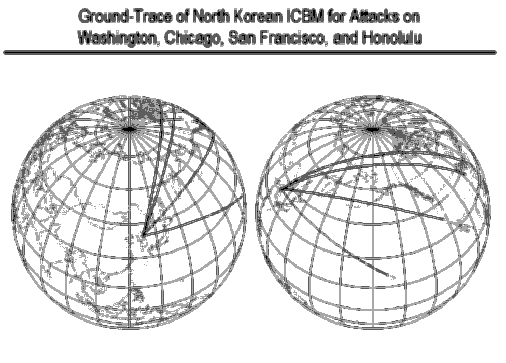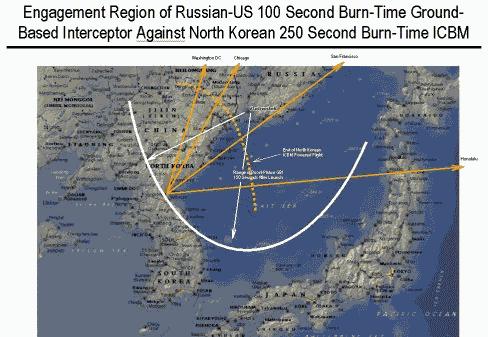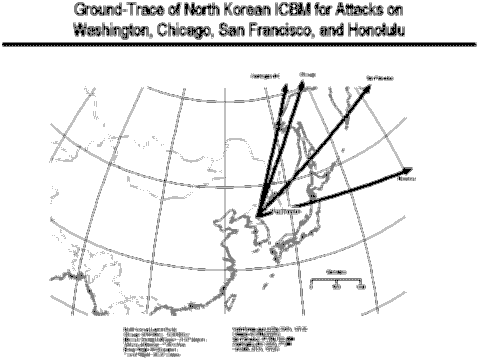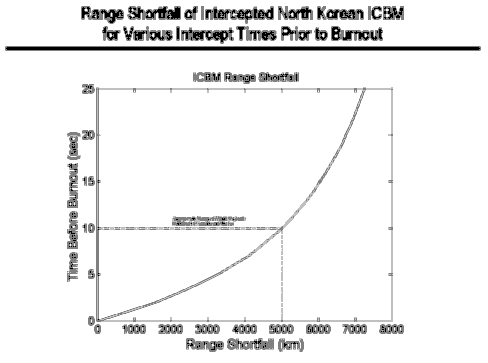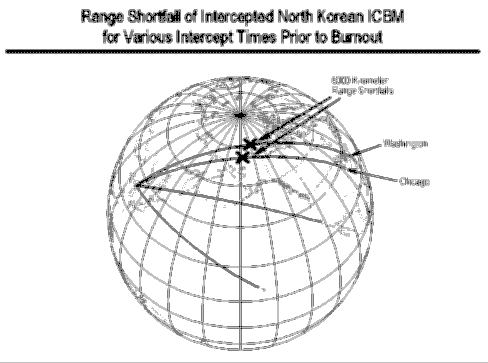
November 17, 1999
COOPERATIVE BALLISTIC MISSILE DEFENSE
Richard L. Garwin
Philip D. Reed Senior Fellow for Science and Technology
Council on Foreign Relation, New York
The United States is committed to develop a limited national missile
defense (NMD), but the decision to deploy will depend upon the
effectiveness and cost of the system; neither the administration nor the
Congress should back a patently ineffective NMD. This paper is motivated
by the judgment that the particular approach to National Missile Defense
currently under development will be judged unable to fulfill its primary
task of defense of the United States against four or five reentry vehicles
from ICBMs launched from North Korea, Iran, or Iraq. And it will not
protect against unauthorized launch of a few of the score of Chinese
ICBMs(1).
These technical problems with NMD system performance can be overcome by
boost-phase intercept (BPI-NMD), a version of which could serve to provide
the protection to the United States that is the primary goal of the
proposed NMD. A system for Boost-Phase Intercept could be deployed
incrementally, initially against North Korea, at a cost which is far less
than that of the proposed NMD system. It could readily be expanded to
cover ICBM launches from Iraq, and with more difficulty to handle launches
from Iran.
It is the purpose of this paper to explore what could be done in this way
and, specifically, to sketch the nature of possible Russian cooperation.
Beyond this sketch, I propose that BMDO study a system along the lines
described, with a view to deploying it to counter the North Korean threat,
as the first step in a limited NMD.
1. THE THREAT, IN CONTEXT, INCLUDING PENETRATION AIDS.
The Rumsfeld Commission on July 15, 1998 reported that an elementary ICBM
force could emerge in North Korea, Iran, or Iraq, within five years of a
dedicated program to produce such a capability, and that for several of
those years, the United States might be unaware of such a program. The
missiles that would be deployed would be inaccurate and unreliable, and
they would be few.
The Rumsfeld Commission also observed that any of these potential
proliferants could more readily and earlier avail themselves of
short-range ballistic missiles or cruise missiles launched from ships that
could attack U.S. coastal cities. The Commission also noted that an ICBM
threat could well include bomblets released on ascent, in order to
maximize the effectiveness of a given payload devoted to biological
weapons (BW) in comparison with a single unitary warhead or with a system
that attempted to dispense BW from bomblets that would be separated on
re-entry.
While the Rumsfeld Commission did not give any dates by which ICBM
capability would actually be expected, North Korea launched the
Taepo Dong 1 on August 31, 1998. To the surprise of the U.S.
intelligence community, this was not simply a two-stage missile, which
would test for the first time North Korean competence in staging, but
proved to be a three-stage system, attempting to launch a small satellite
into orbit. Although the third stage failed before burning to completion,
the test did show that North Korea was able to separate successive stages
and to ignite the liquid-fueled second stage in space.
The launch of a Taepo Dong 2 is expected at any time, unless North Korea
agrees to postpone or abandon this launch; a third stage could provide an
inaccurate ICBM capability for striking U.S. territory. This
characterization of the threat is in agreement with the September 1999
NIE(2) "Foreign Missile Developments and the Ballistic Missile Threat to
the United States Through 2015", which in addition states
"We assess that countries developing ballistic missiles would also develop
various responses to US theater and national defenses. Russia and China
each have developed numerous countermeasures and probably are willing to
sell the requisite technologies.
"Many countries, such as North Korea, Iran, and Iraq probably would rely
initially on readily available technology-- including separating RVs,
spin-stabilized RVs, RV reorientation, radar absorbing material (RAM),
booster fragmentation, low-power jammers, chaff, and simple (balloon)
decoys-- to develop penetration aids and countermeasures.
"These countries could develop countermeasures based on these technologies
by the time they flight test their missiles."
The proposed NMD system with 20 deployed interceptors is evaluated against
a very limited ("C1") threat of four or five simple reentry vehicles, with
very limited countermeasures or penetration aids-- less extensive than
those expected by the 1999 NIE. I am skeptical that a nation that will
deploy a few ICBMs to threaten the United States with BW attack, will do
so without making the great improvement in effectiveness that would result
from packaging BW in individual bomblets weighing 1 kg or less, separated
on ascent, that would fall to their targets and disseminate the BW agent
after impact. Reasonable designs of such bomblets are available from the
U.S. program of the 1950s and 1960s, in documents released by the U.S.
government over the decades. In addition, the general evolution of
technology is such that dissemination experiments with simulant-filled
bomblets would be easy to do, essentially harmless, and would not involve
space trials.
It is categorically impossible for the NMD system under development to
counter these bomblets once they are dispensed on ascent.
In the case of a few ICBMs each armed with a reentry vehicle (RV) carrying
a nuclear warhead, bomblets could not be used, of course. But the offense
could make use of a low-tech countermeasure that would not attempt to
defeat the proposed NMD system by stealth (invisibility to radar or
infrared), but would counter the specific "hit-to-kill" interceptor.
Thus, the NMD could work perfectly, with alerting from the DSP infrared
satellites, launch of interceptors from their bases in Alaska or North
Dakota, and homing of the interceptor on the one large object in view.
But if that object were a house-size aluminized mylar balloon ten meters
in diameter (33 feet) the kill vehicle would pass harmlessly through the
balloon. In the vacuum of space, the deployment of such a balloon could
be done in one second by a tiny charge of gas-generating material like
that of the normal automobile air bag, and successive balloons might be
deployed as well, to counter a tactic of a first interceptor popping one
balloon to reveal the RV to the next interceptor.
I regard such countermeasures as credible and a minor effort compared with
that of creating an ICBM force; the 1999 NIE draws similar conclusions,
apparently without dissent in the community.
2. BOOST-PHASE INTERCEPT FOR NATIONAL MISSILE DEFENSE.
Intercept of the ICBM while it is in boost-phase would evidently prevent
bomblets from being dispensed or from reaching their intended target. The
third stage of an ICBM intercepted ten seconds before burnout will fall
5000 km short of its target-- entirely outside the United States and
Canada.
The ICBM second stage or third stage is evidently a much more visible
target than is a trash-can size RV in space, because of the very visible
rocket flame that is seen by the DSP satellites from a distance of
40,000 km. Not only is there a lot more energy radiated by the rocket
flame, but it can be sensed in the mid-wave infrared or even in the
visible, in comparison with the long-wave infrared required for the seeker
of the NMD interceptor as it is proposed.
The only capability under development for Boost-Phase Intercept is the
airborne laser (ABL), funded by the Air Force, which is always discussed
as a component of Theater Missile Defense rather than as an adjunct to or
component of NMD, perhaps to avoid the political stricture (of the 1972
ABM Treaty) against air-based strategic BMD or BMD using "other physical
principles."
But National Missile Defense will in any case conflict with the ABM
Treaty, literally interpreted, and it is worthwhile to look at Boost-Phase
Intercept system options to ask what would be involved, how effective they
would be, and what treaty modifications or other measures would be
required for implementation. A BPI-NMD system along the lines sketched
below would involve mainly proven technology and hence be available in a
shorter time and with less technical risk than ABL. It would have the
obvious advantage of not requiring large aircraft to remain airborne at
all times in order to provide continuous coverage, and it has a greater
range of intercept than does the ABL.
The basic system considered here would involve detection of ICBMs by the
existing DSP satellites, rough determination of the direction and
trajectory, and command of interceptor launch within 50 seconds of the
actual launch of the ICBM. Assuming that the interceptor must be launched
from outside the territory of North Korea, Iraq, or Iran, and wishing to
be conservative and to make use of as much of the BMDO program as
possible, I assume the employment of the NMD interceptor rockets for
BPI-NMD. This is a three-stage system apparently capable of some 8.5 km/s
velocity, comparable with the speed of an ICBM (7.5 km/s). The
interceptor may need to be modified to reach its ultimate speed in no more
than 100 seconds of powered flight.
The highly sophisticated four-band seeker planned for the NMD system would
be replaced by a much simpler one with lower resolution and lower
sensitivity, operating in the mid-ir or near-ir bands. The interceptor
would always see the rocket flame above the horizon, so it would not have
the problem that DSP solves by viewing in the water vapor absorption band
to avoid seeing thousands of square kilometers of warm Earth. The seeker
for the BPI-NMD role has an easier task than the DSP sensor that has been
available for more than 30 years, that detects a rocket plume anywhere on
the visible side of the Earth using an 8-inch telescope from 40,000 km
distance. In contrast, the seeker for BPI needs to detect from 1000 km
against the background of space. The BPI (Boost-Phase Interceptor) would
be self-guided as soon as its seeker acquired the thrusting rocket in an
approximate region designated by DSP. It would home initially on the
rocket flame, but then as it approached, it would need to "lead" the flame
in order to strike the hard body of the rocket. At that point, an
uncooled infrared imager could be used to see the rocket itself, from a
distance of about 10 km. Impact essentially anywhere on the thrusting
rocket structure would disable the vehicle.
North Korea is likely to be the first new ICBM threat to the United
States. Figure 1 shows the end of North Korean ICBM powered flight,
assuming 250 second burn time, and it shows the intercept capability of a
BPI launched from Vladivostok with a burnout speed of 8.5 km/s after
powered flight of duration 100 seconds. The contour is the location of
the interceptor 150 s after GBI launch. This assumes that the GBI is
launched 100 seconds into the ICBM flight instead of 50 seconds-- a very
conservative assumption.
Figure 2 shows the ground trace of North Korean ICBM trajectories aimed
for Washington, Chicago, San Francisco, and Honolulu.
Figure 3 shows the powered flight profiles of the ICBM and the GBI.
Evidently these assumptions would allow a GBI to be launched from anywhere
within about 600 km of the burnout-point of the ICBM and still make
intercept, launching 100 seconds after ICBM launch. Basing areas thus
include not only Vladivostok and the strip of Russia south of that city,
but also large ocean areas in the Japan Basin.
Figure 4 shows the decrease in range caused by intercepting the ICBM third
stage a given number of seconds before burnout. In the last ten seconds
the ICBM moves about 70 km, and intercept by 240 seconds rather than 250
seconds poses little additional difficulty, but it results in shortfall of
the payload by 5000 km. These calculations are made for nominal
trajectories. Toward burnout the third stage of the ICBM has an
acceleration ten times that of gravity, or more. The homing system of the
GBI might have to intercept with a target uncertainty of 1 g, but that
should be well within its capability.
Of course, the precise aimpoint of the ICBM is not known, and there are
many possible targets in the general direction of Washington from North
Korea. But Figure 4 shows that an ICBM heading for one city rather than
another in the United States, even though they are spaced 1000 km apart
along the trajectory, corresponds to a difference of about 1.5 seconds of
powered flight. Since it is unlikely that the intercept would be made in
the last five seconds of flight, it is clear that the effectiveness of GBI
is not reduced by the lack of knowledge of the particular target, and thus
intended burnout time.
IRAQ AND IRAN.
Fig. 5 shows trajectories from a launch in central Iran toward Washington,
San Francisco, and Honolulu. Those missiles directed toward the
continental United States could be intercepted in boost-phase by GBI based
on a ship in Caspian Sea or from southeastern Turkey.
All launches from Iraq against the United States could be intercepted from
a GBI site in Turkey.
PROBLEMS AND COUNTERMEASURES.
Countermeasures to such a BPI-NMD system (i.e., choices which would not
ordinarily be made in the normal development or operational process) would
include redesign of the ICBM to be a "fast-burn" missile, or launching of
dummy first-stage missiles to provoke the launch of interceptors, when
there will be no ICBM at all as a result. The report to the American
Physical Society on Directed Energy Weapons (1987) showed that for modern
U.S. technology there would be only about a 5% reduction in ICBM payload
in moving from a normal 250-s powered flight to a 100-s powered flight
duration, but this is not a natural thing to do in an ICBM development
program. It would require engines 2.5 times as powerful, which would
reduce the payload to zero for the heavy engines and structures of an
early ICBM design.
As for the launch of dummy first stages (that is, first stages with
ballast instead of the fueled and loaded second and third stages), the
nominal 30-s burn time of the ICBM first stage is short enough to allow
the GBI launch to be cancelled, even for planned 50-s firing delay. In
the Figures, 100-s firing delay is assumed, so that a dummy would need to
have both credible first and second stages.
More detailed calculations are required, of course, actually to design a
GBI system.
3. ABM TREATY CONSIDERATIONS.
The 1972 ABM Treaty does not restrict the number of ABM test sites, and so
it would pose no inhibition to having some interceptors at a new joint
U.S.-Russian test site near North Korea. These interceptors might then be
used in an operational role.
Presumably DSP would be grandfathered, as having been in existence in
1972. And the self-homing interceptor could also be agreed under the
Treaty.
More difficult is the Article-V problem posed by sea-based interceptors
even on ships that have no ABM radar, as is proposed here.
The two sides in this Treaty (with the Soviet Union's side expanded to
consist of Russia, Belarus, Kazakhstan, and Ukraine) could agree to a
specific system. The guiding principle is that agreed in New York in
September 1997 in regard to TMD demarcation, that the system should not be
directed against the other side, and should not pose a realistic threat to
the strategic force. Neither of these problems arises in conjunction with
the proposed system.
It seems that one of two general approaches might be taken to allowing
this BPI-NMD system, while preserving the ABM Treaty:
o The ABM Treaty might be amended in many of its sections and clauses to
provide elbow room to accommodate systems that would counter the
threats from countries newly deploying ICBMs.
o Rather than numerous specific modifications to the ABM Treaty, the two
sides might agree on a self-contained Protocol, which would require
approval by the Senate, stating simply,
"Recognizing the intent of the ABM Treaty of 1972 to limit the
defense of the national territory of each Party against the strategic
ballistic missile forces of the other Party, the Parties hereby
accept the deployment of a specific system for protection against
ballistic missiles of certain other states, as follows:
1. Interceptors deployed at sites on the territory of any Party to
the Treaty, operated jointly (by Russia and the U.S.).
2. Interceptors (give specifics of proposed NMD interceptor airframe)
equipped only with uncooled seekers and deployed on ships without
ABM radars, operating in the Japan Basin, the Gulf of Oman, or the
Caspian Sea.
3. Other systems that may from time to time be specifically agreed by
the Parties."
4. WHAT AND WHETHER OF RUSSIAN COOPERATION.
Russia needs in any case to cooperate in modifications to the ABM Treaty
if this BPI-NMD is to be deployed under the Treaty, even on U.S. ships.
Alternatively, of course, the United States could state that it will move
ahead to deploy such systems under the ABM Treaty, using the supreme
national interest clause six months in advance of taking measures that
would otherwise be forbidden by the Treaty.
Russian BMD developers would probably be pleased to cooperate with the
United States in a ground-based system south of Vladivostok. The
political side might be less than enthusiastic, possibly regarding this as
a potentially provocative act toward North Korea.
Russia has good interceptor technology and would have no difficulty in
providing a design that could be launched from the Vladivostok area.
Given such cooperation, it might well be that Russia would not object to
the U.S. deployment of its own similar interceptor on naval ships. Russia
could easily match a U.S. deployment of a few dozen BPI on military cargo
ships, so this approach should not feed fears of a natural U.S. advantage
as the dominant sea power. It would be a simple matter to agree on ocean
areas from which these ships might fire, with cooperative and verifiable
means to prevent them from doing so in other regions.
5. SUMMARY
Against a potential North Korean ICBM threat to the United States, a
limited NMD system based on boost-phase intercept (BPI-NMD) could be
deployed cooperatively under the ABM Treaty, amended with a suitable
protocol. It would provide protection against BW bomblets released on
ascent, as well as against penetration aids such as enclosing balloons
that would defeat a mid-course NMD system.
A joint ABM deployment site in Russia south of Vladivostok would be an
ideal location for the self-guided interceptors of such a system.
Alternative or additional capability would be provided by similar
interceptors based on U.S. military cargo ships in the Japan Basin.
Protection against an ICBM threat from Iraq could be provided by GBI based
in Turkey, and against potential threats from Iran by GBI based in Russia
or Kazakhstan, and on military cargo ships in the Gulf of Oman.
6. PRACTICAL STEPS TOWARD A COOPERATIVE BPI-NMD.
o It would be desirable for the Department of Defense to contract on an
urgent basis for studies of a GBI-NMD system using DSP and self-guided
interceptors. This should be done with a schedule that would permit a
deployment decision that would meet the desired NMD operational date
of 2005.
o The general approach should be discussed with Russia and the other ABM
Treaty Parties of adding to the ABM Treaty a protocol that would
simply permit specific systems as agreed among the Parties.
Encl:
-Fig. 1: Map of North Korean area and Japan Basin.
-Fig. 2: Ground trace of North Korean ICBM trajectories.
-Fig. 3: Powered flight profiles of ICBM and Ground-Based Interceptor.
-Fig. 4: Decrease in range vs. number of seconds curtailment of boost.
-Fig. 5: ICBM trajectories from Iran to U.S.
RLG:jah:Y321CBMD:111799CBMD
----------------
1 China could not afford to ignore a limited NMD system and could surely
mount effective penetration aids, which would deploy also during an
unauthorized launch.
2 http://www.cia.gov/cia/publications/nie/nie99msl.html (unclassified
version).
Y321CBMD Secretary's Open Forum 11/18/99 11/17/99

